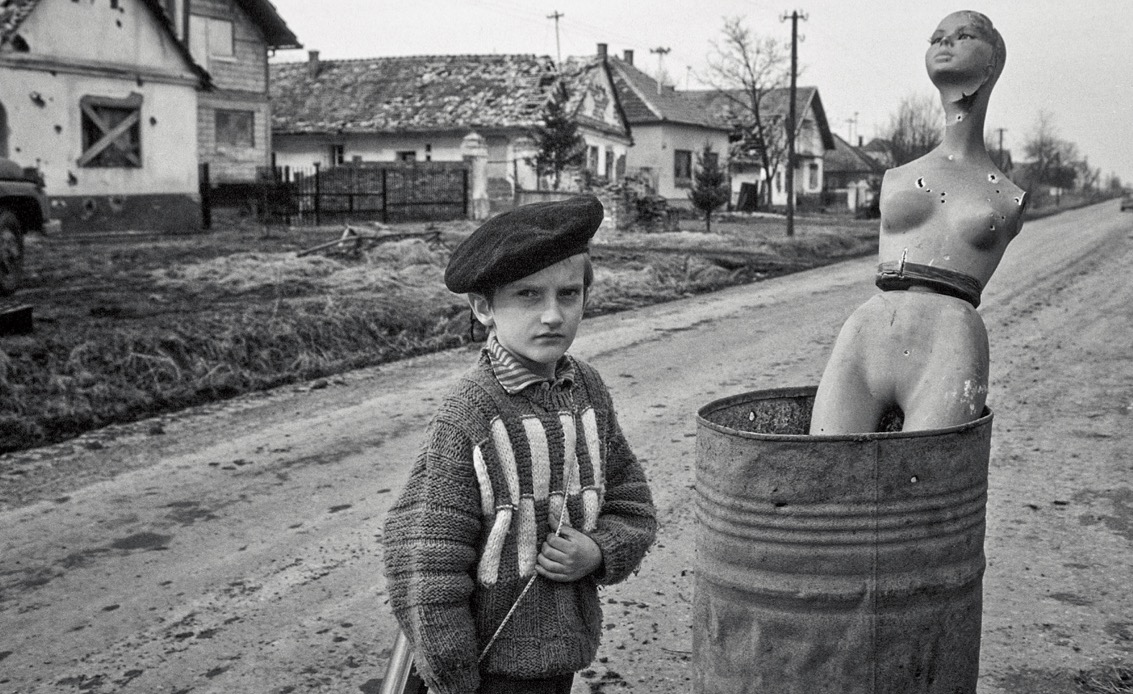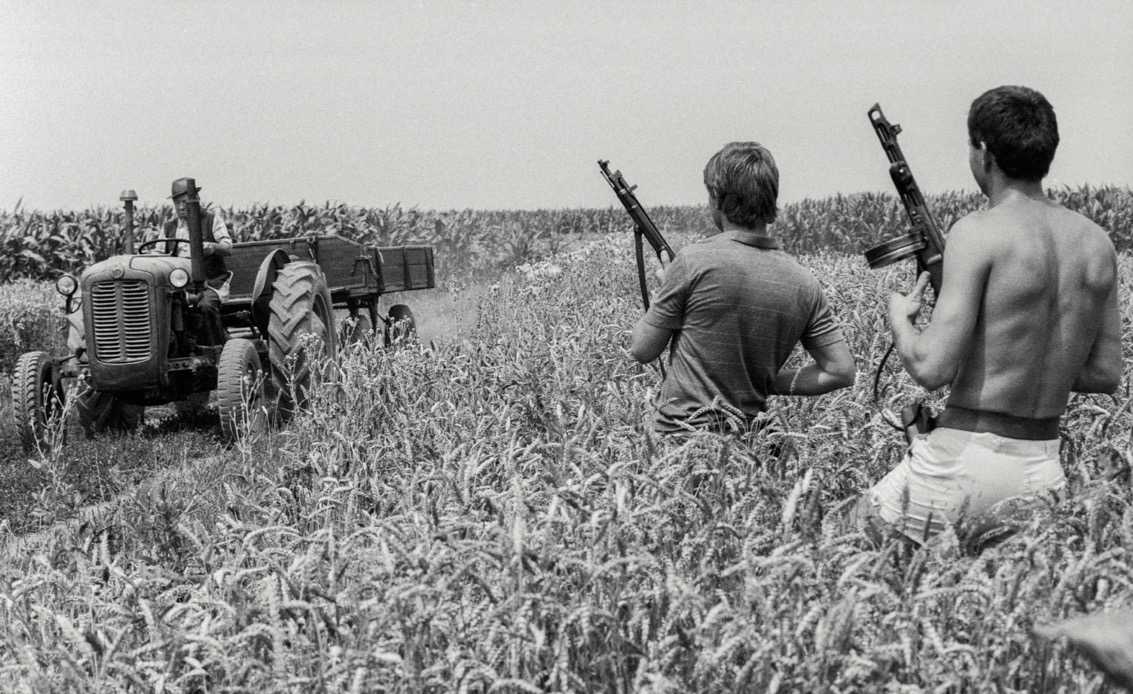In remembrance of the nineties or the bitterness in the eye.
Text: Vera Blagojević Ugrinov , English translation: Vanja Milenkovski
Life appears quite fascinating when viewed through the lens of a military photo-journalist. It appears surreal and unpredictable. As if nonexistent. The paradox of the “still of the moment” documented by the camera is incredible. In taking photos, Imre Szabó distinctively reveals the dynamism of everything that comes with war. Observing the reality “captured” by the camera, he reveals the moment of what will not happen again. The power of the photograph we are seeing, the impulse and the flame of the author’s eye lead us to assume that documenting war is one of the most intense experiences. It is a grand achievement which takes great skill to preserve the cruelties that Szabo followed in the nineties. He documented the truth, courageously and extraordinarily reporting from a battlefield. He photographed the darkness of war and its reality.

The viewer begins to understand, from the fire and the ardour of the faces and landscapes – that the „still of the photograph“ is lost, and they bring the recorded events back – all is in motion, all burning before our very eyes. Imre Szabó shows us a photo which is – alive. We begin to comprehend that a military reporter is a shadow moving through the war zones as if through a red line of the abyss. We begin to comprehend why the artist wants the events and the people amid the terror of war to be remembered. We begin to comprehend that the moments captured on the battlefield show not only the cruelties – the photographs record the essence – but the dark side of the human nature. Does war, as a certainty, represents man’s hidden urge for self-destruction. Where has the joy of life been lost, which metal shroud has hidden the beauty, what image of the sky was set ablaze, coming apart and falling on humanity’s head. What iron shackles hold the heart when the man’s dark nature is being revealed. We wonder where the other side was lost, the one which is delicate and emotional, the one that draws inspiration from the splendour of the landscapes, the shades of the sky and the triumph of the beauty of our existence. It seems that there is but a single truth – the WAR photograph is a document on the DEBACLE of life.

What the lens shows us when we look at the faces of the warriors and the places in which they were photographed. In the moment when our consciousness awakens to the cruelty, it simultaneously appears as though the enflamed war signals from the photo hurt our sensitivity, that they attack the beauty and the sense of a splendid life. And then a part of our consciousness reacts promptly, so as to protect us. We find ourselves in a dumbstruck disbelief. We delude ourselves that everything the photos show is – impossible. In our desire to believe, we go as far as to say “the war photos are the work of a skilled producer on how war should look like“. But we know it is the work of a good eye and camera lens. However reluctant to accept it, we understand the truth of cruelty and desperation. And the truth is clear even when the photo is not, when the place is blurry, photographed while the author was running or lying flat on his belly on the shaking ground. We understand that the moment of truth shown to us by Imre Szabó is forever “captured” in the chaos of war…
Not a single moment before a war photo can be spent without thinking of risk, fire and life, for the war reporters live a life of war. They are at a serious risk even when far behind the battle lines. Every step is one of danger on land, on the road, wherever they go. The only thing Imre Szabó leaves out is how one faces the terror. But each photo tells us that a photo-journalist possesses but a single “instrument of war“ – his camera. And fearlessness. The subjects of the photos are gunpowder, explosions, bombs, armed men… Patrols, rations, arrests, makeshift hospitals, firefighters. The fires of torpedoes and rifle grenades. The companions on humanitarian missions and the wounded in the barracks, encampments and prisons that attest to the battles. On sacrifice. On death that war brings. War reporters are the WITNESSES of history. And we see the legacy of that history. Darkness and shadows.
Imre Szabó shows us the shroud of desperation that follows people. Makeshift coffins, the darkened brows of old women. Clenched jaws, tearless eyes, for pain is like a poisonous coil in the soul. The faces of the warriors, firm, courageous, in full battle equipment. Uniforms and guns, cartridge belts across the chest in which lies a pounding heart. And bombs. The photos tell us that war is polished helmets, army shirts, guns, bullets, pistols. War is also the photos of loved ones in the breast pocket. The faces left behind to dread and wait… And we see this entire conglomerate of destructive materials in the photographs. Every one of those lethal instruments has arisen from darkness. And every one can be the mark of death.
The focus and clarity of Szabó’s photos tell us that one’s hand and, indeed, entire being must be calm and collected as they operate the camera. They must be unrelenting.
The war photographer’s profession has the bravery which follows its mandate – to find a way to protect the sensitive human being from fear. Photo-journalists understand that even away from the battlefields, in the surrounding areas, there are people who live in fear of war. They protect their homes, children and yards. In order to escape the conflict and cross from one side to another, temporarily peaceful and where the sounds of gunfire have died down, the civilians pass across the roads and crossroads still patrolled by snipers… Even in saving their lives, people are exposed to brutality and suffering, sorrow and self-sacrifice.
When asked about the pressure and the heavy burden on the soul of a war reporter, we have no answers… Does the heart tremble as it documents and records pain, bewildered eyes, the consequences of bombs and lost children? It records the bitter truth as a warning to the world. Of dread, of facing the panic. Imre Szabó does not record war from a distance. Looking at his photos, we realise that he was standing right before gaping jaws. There is only focus, the eye and the camera. And the moment in which the camera shutter closes. We believe that he is guided by a personal imperative – to reveal truth with his photo-documents, to make the world see sense, if only for a moment. To move mankind at least an inch forward. We realise that these photos are – the artist’s mission and a personal “war“.
And finally, we realise that they are also a part of war – the photo-journalists themselves, on duty. War is also the meadows, the pine trees, the skies. When the battle cry breaks, all is at war.
An experienced war reporter is a man performing his duty diligently and who is firstly and fore mostly guided by his conscience. In the eye of the storm, the only mandate is to preserve the document. To record and collect the truths of war and the people who live through it. Behind the camera lens,Imre Szabó, on duty as a war photographer, captures moments which convey the spirit and the essence of military operations. He takes photos of war, and those photos are relevant not only for his technique and quick reflexes, or their history, but they also have an extraordinary depth of powerful emotions that depict the subject of the photo itself. The proof of a cruel humanity.
In looking at the cycle of the extraordinary war photographs, we see the bestial face of war. We believe that when Imre Szabó packs up his camera and leaves the battlefield, there remains a painful awareness of war. There also remain the people who fight and those who live with a bitterness in their eyes.

When the war is over, when the fog and the thick smoke forever enshroud those bygone days of terror, the flaming storm of war burns out. There is hope beyond the darkness. A new life begins. The life from the other side. Filled with light. Filled with splendour. The life that triumphs.
You can find him here: Imre Szabó




